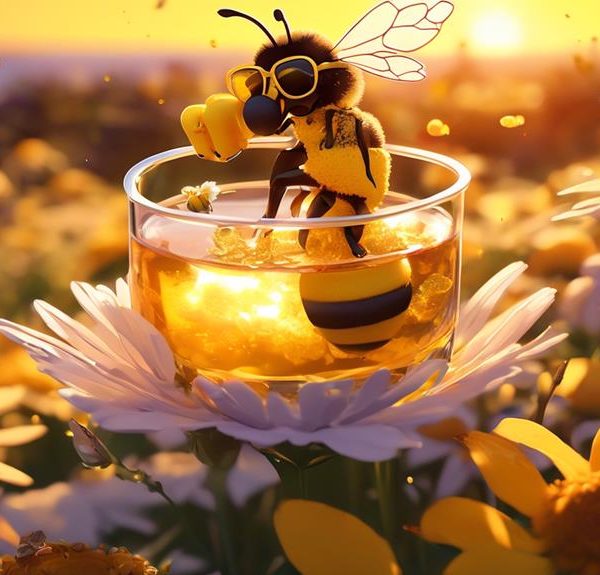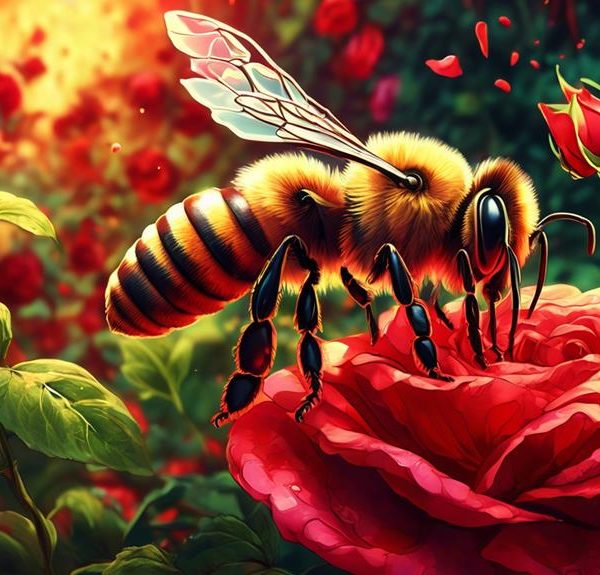Harness the mystery of bee flight as we uncover whether these tiny powerhouses can truly hover, in an exploration of nature's remarkable aerial acrobatics.
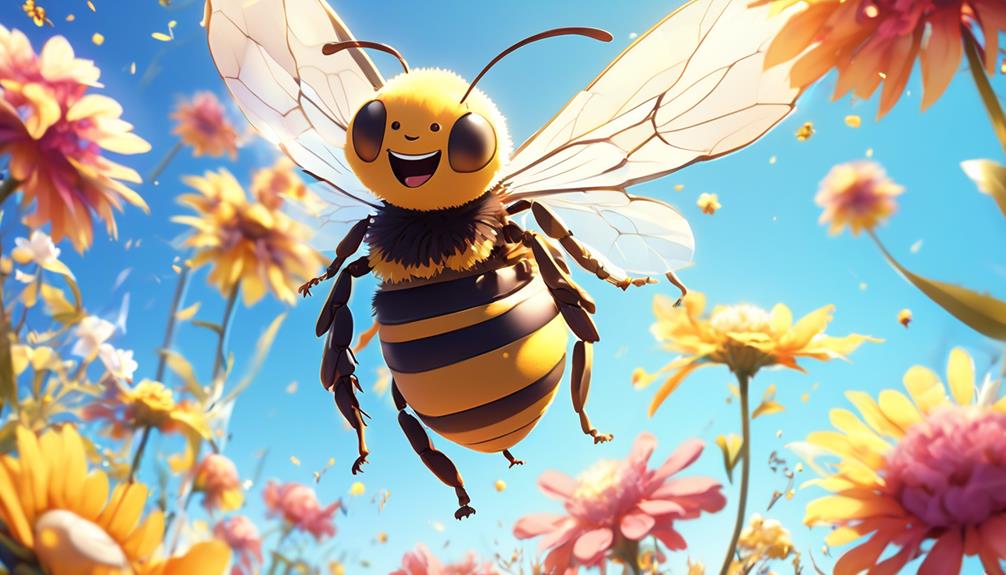
Can Bees Hover?
In the delicate dance of nature, where hummingbirds pirouette and eagles soar, you might not consider the humble bee as a master of aerial acrobatics. Yet, the seemingly clumsy bumblebee, with its rotund body and seemingly disproportionate wings, is capable of remarkably agile feats in the air.
The question at hand: can these industrious insects actually hover? You've likely witnessed them darting about your garden, buzzing from flower to flower, but have you ever stopped to consider the mechanics of their flight?
Let's embark on an exploration of the remarkable capabilities of bee flight and the factors that allow these tiny creatures to accomplish such an extraordinary act.
Key Takeaways
- Bees have a lightweight body structure with a chitinous exoskeleton.
- Bees' wings beat at 200 times per second, allowing them to hover and fly.
- Hovering is essential for bees to effectively forage and reach inaccessible flowers.
- Factors such as wind, temperature, and health status can affect bees' ability to hover effectively.
Understanding Bee Anatomy
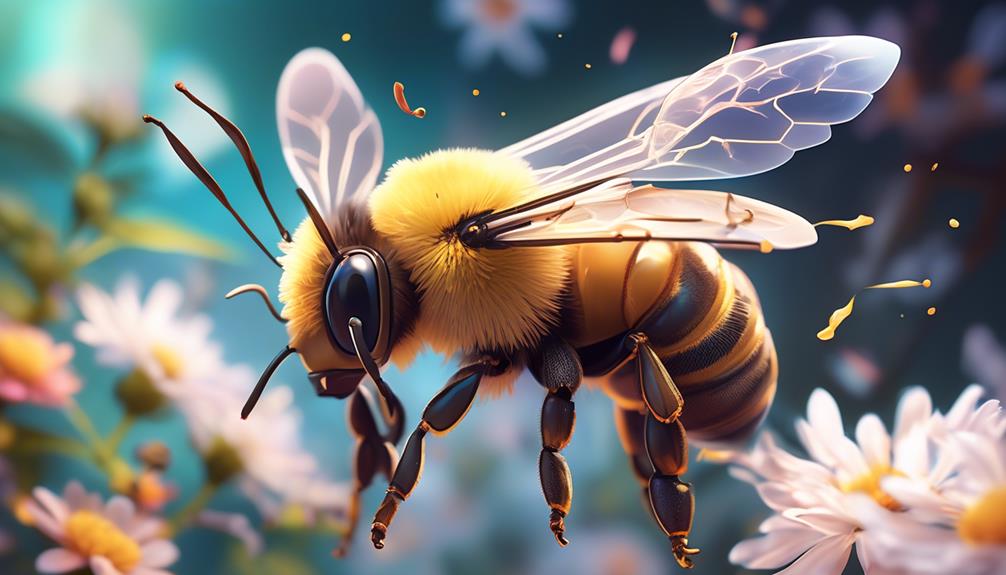
To truly grasp how bees can hover, you'll need to delve into the intricacies of their anatomical design. At the core of their ability lies a unique combination of their lightweight body structure and highly efficient wing design. The bees' bodies are covered with a chitinous exoskeleton, a lightweight yet durable material that provides the perfect balance between strength and weight.
The wings, however, are the most fascinating aspect of their anatomy. They're not just thin and flat appendages, but complex structures composed of a network of veins that provide rigidity and strength. They beat at an astonishing 200 times per second, creating the lift necessary to hold the bee's weight in the air.
A closer look at the bee's thorax reveals a set of powerful muscles moving the wings up and down in a figure-eight pattern. This motion generates lift from both the downstroke and the upstroke, a mechanism that's essential for hovering.
Understanding these anatomical marvels, you'll begin to appreciate how bees accomplish the intricate ballet of hovering, an accomplishment that continues to inspire scientists and engineers in the field of aviation.
The Biomechanics of Bee Flight
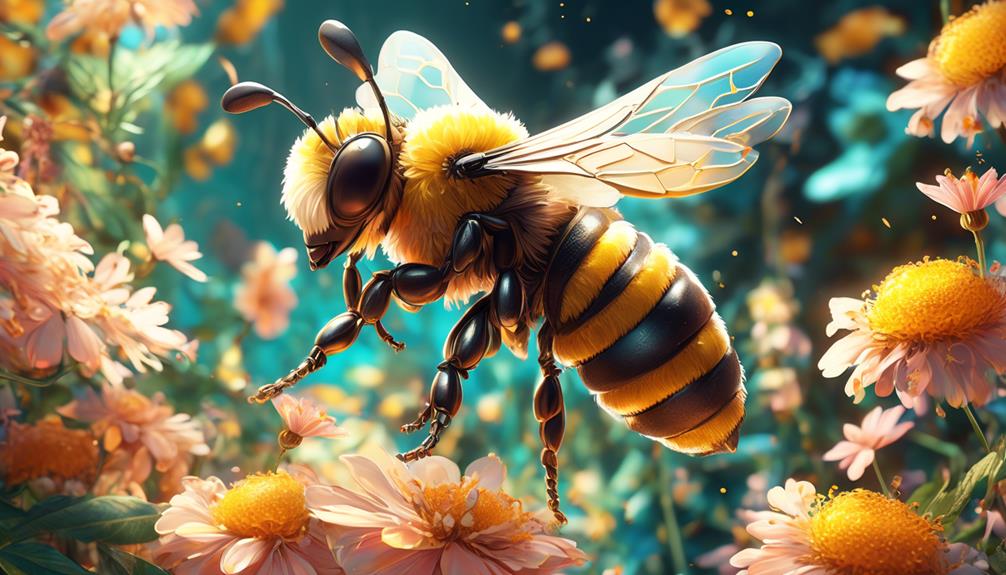
Building on our understanding of bee anatomy, let's now explore the biomechanics of bee flight, a complex process that relies heavily on the precise coordination of their unique anatomical features. Bees have a pair of large compound eyes, two pairs of wings, and three pairs of legs. These body parts work together in an intricate ballet of physics and biology to allow bees to fly.
Here's a table that breaks down the biomechanics:
Body Part | Function | Importance in Flight |
|---|---|---|
Eyes | Detect light, shapes, and colors | Navigate and find flowers |
Wings | Generate lift | Enable flight and hovering |
Legs | Grab and carry pollen | Aid landing and taking off |
Notice how each part plays a critical role. The eyes, for instance, aren't just for seeing; they're essential navigational tools. The wings, while providing lift, also create the unique buzzing sound we associate with bees. The legs, besides their obvious function in walking, are vital for landing and taking off.
Can Bees Actually Hover?
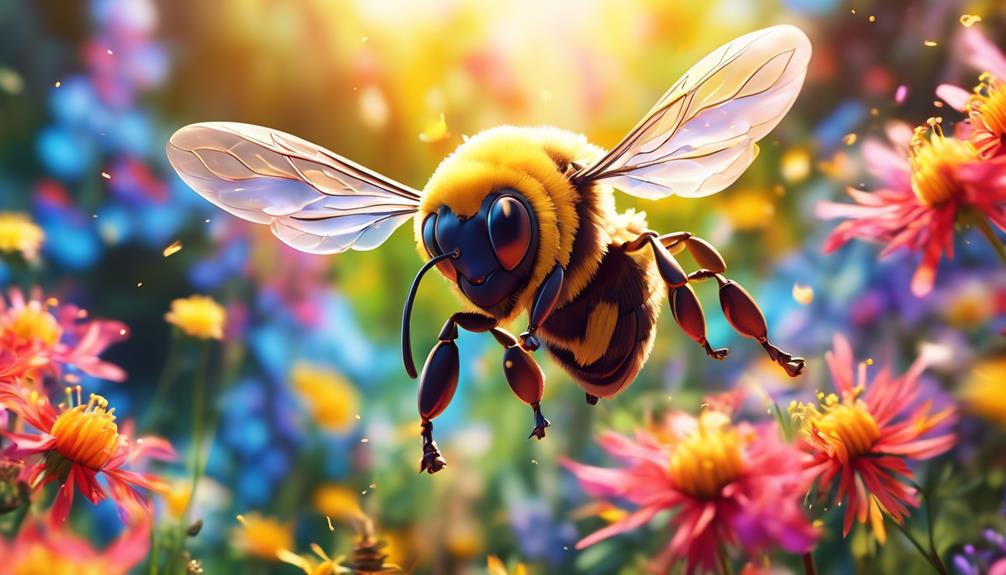
Yes, bees can indeed hover, a capability that isn't only fascinating but also crucial for their survival and propagation. You might wonder how they manage this feat. The answer lies in their complex wing mechanics and body design.
Bees possess a pair of large compound eyes that allow them to effectively navigate their environment while hovering. Their wings, unlike those of most insects, can flap back and forth at a remarkable speed of about 200 beats per second. This rapid wing movement generates enough lift for the bees to hang in the air, almost as if they're defying gravity.
Their bodies are lightweight, and their wings are designed in such a way that they can tilt and rotate to adjust the direction and speed of their flight. Additionally, bees can control the amplitude and frequency of their wing beats, which gives them an impressive maneuverability while in flight.
This hovering ability is vital for bees as it allows them to forage effectively, reaching flowers and plants that are otherwise inaccessible. So, the next time you see a bee buzzing around your garden, remember, it's not only flying, it's also performing a complex, aerodynamic ballet.
Factors Affecting Bees' Hovering Ability
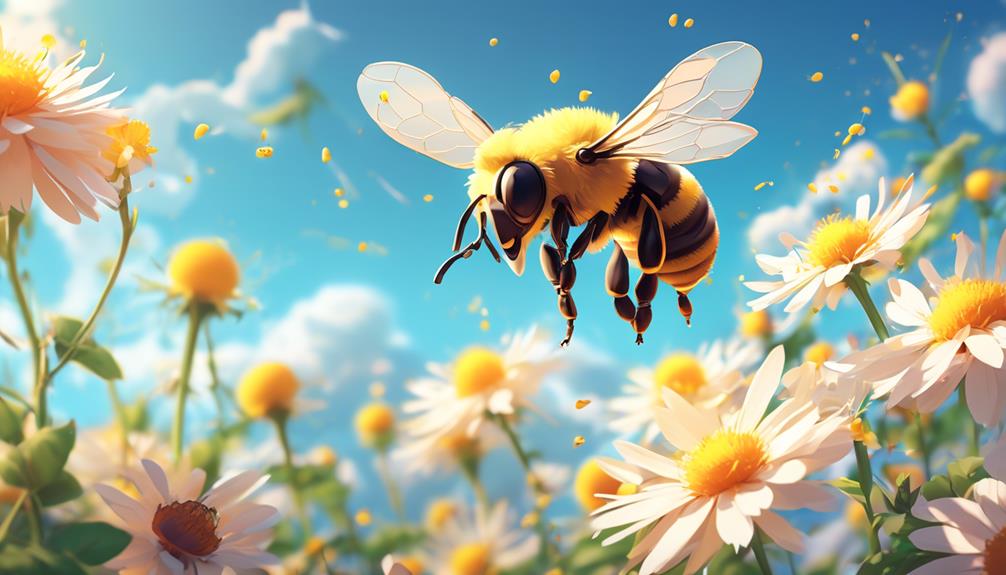
While bees are adept at hovering, various factors can impact their ability to perform this complex aerodynamic act. You should consider that a bee's ability to hover isn't solely dependent on its physical strength. Wind conditions, temperature, and the bee's health status all play crucial roles.
Wind conditions, for instance, can greatly affect a bee's stability while hovering. A strong gust can throw the bee off balance, making it harder to maintain position and high energy expenditure. You'll find that bees may struggle to hover in turbulent conditions.
Temperature is another significant factor. Bees are ectothermic, meaning their body temperature is influenced by the environment. In colder temperatures, bees become less active and their muscle activity decreases, hindering their ability to hover. Conversely, warmer temperatures can overheat them, resulting in exhaustion and decreased hovering ability.
Lastly, a bee's health status, including age and disease, can affect its hovering ability. Older bees may not have the same strength as their younger counterparts, while diseases can weaken a bee's body, reducing its ability to hover effectively.
Significance of Hovering in Bee Behavior
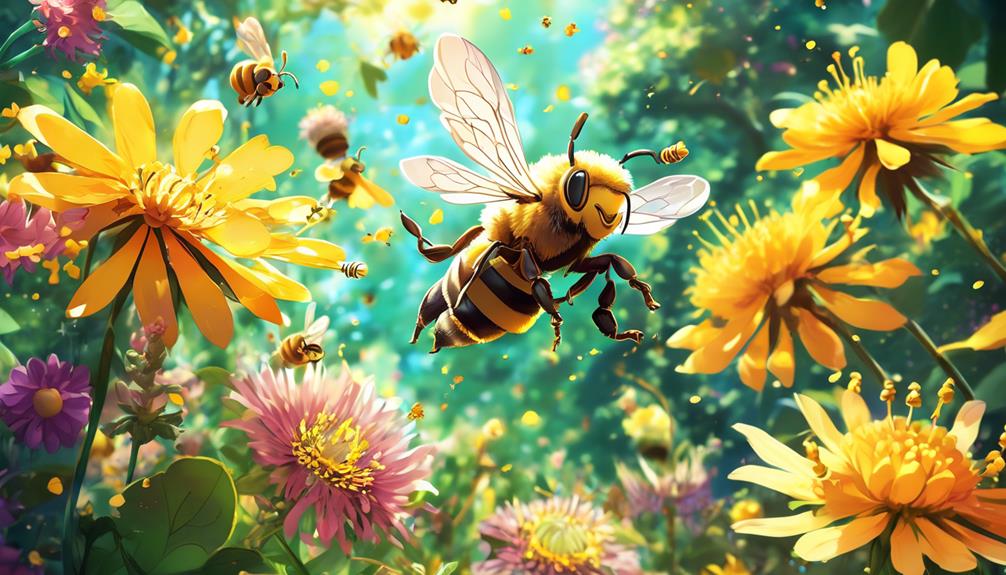
Hovering plays a crucial role in bees' behavior, significantly impacting their foraging habits, mating rituals, and defensive strategies.
As you study bees, you'll find that their ability to hover allows them to access nectar from flowers while remaining airborne. This skill is necessary for efficient foraging, enabling bees to visit more flowers in less time, optimizing their energy expenditure.
In terms of mating, hovering takes center stage. Male bees, or drones, hover in specific areas known as 'drone congregations' where they wait for a chance to mate with a queen. With their hovering ability, they can swiftly move to intercept a passing queen, demonstrating the significance of this skill in their reproductive success.
Hovering also serves a defensive purpose. When a threat is detected, worker bees hover around the hive entrance, creating a 'bee curtain' that deters intruders. This active defense strategy showcases the tactical advantage of hovering.
Amazing Hovering Bees: Real-life Examples
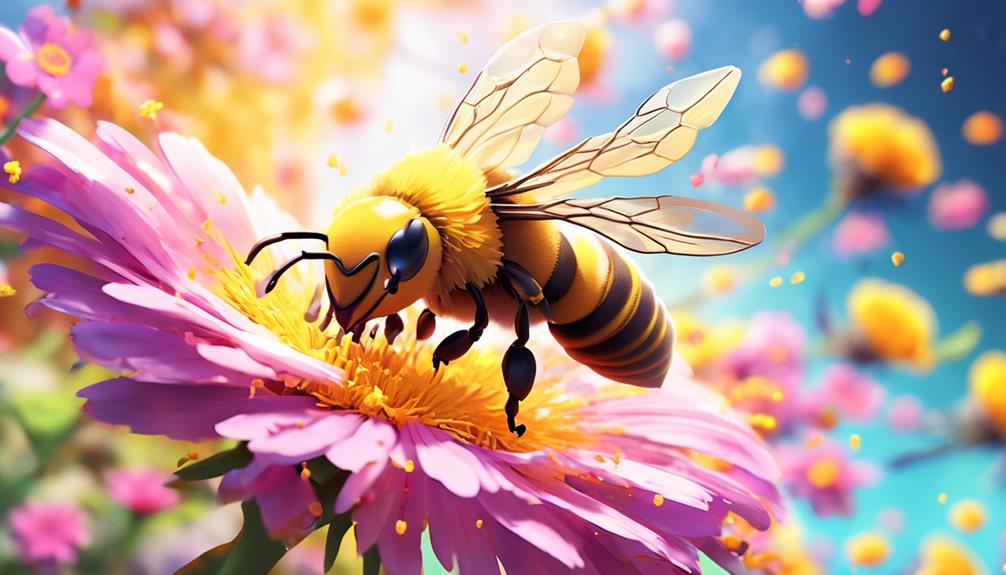
Now that we've analyzed the importance of hovering in bee behavior, let's examine some fascinating real-life instances that highlight this incredible skill.
You've likely seen honeybees hovering around flowers, collecting nectar during the warm months. But did you know that bees can hover for up to 40 minutes at a time? This feat of endurance is due to their adept energy management and their wings' high flapping speed – an impressive 200 beats per second!
Consider the example of the Giant Asian honeybee. It's known for its mass hovering behavior, where thousands of bees hover together to protect their hive from predators. Their collective movement creates a 'wave' effect, which confuses and deters potential attackers.
Another example is the bumblebee. Despite its large body and tiny wings, it can hover and even fly backwards! This is thanks to its unique wing movement, where the wings flap back and forth at a high frequency, creating enough lift to keep the bee aloft.
These examples illustrate the remarkable adaptability of bees. They've evolved these astonishing hovering skills to survive and thrive in their environments.
Frequently Asked Questions
What Is the Average Lifespan of a Bee?
Sure, you're curious about the average lifespan of a bee. It's actually quite variable depending on the type of bee.
Worker bees typically live for 5-6 weeks, while drones live around 8 weeks. However, the queen bee outlives them all, surviving for several years!
This lifespan difference is due to their distinct roles in the hive.
What Role Does Hovering Play in the Pollination Process?
Hovering plays a crucial role in pollination. As you observe a bee hovering over a flower, it's actually collecting pollen on its body. Then, it moves to another flower, the pollen brushes off, fertilizing the plant.
This process, known as cross-pollination, is essential for plant reproduction. So, when you see a bee hovering, it's not just floating aimlessly, it's actively participating in the vital cycle of life.
How Does Weather Affect a Bee's Ability to Hover?
Yes, weather greatly influences a bee's ability to hover. In colder temperatures, a bee's wing muscles may not work as efficiently, making hovering more challenging.
Rain can also hinder their ability to hover due to the weight of the water droplets on their wings.
Windy conditions can blow them off course, making hovering and maintaining position difficult.
Are There Any Specific Species of Bees That Are Better at Hovering?
Yes, certain species of bees are indeed better at hovering. For instance, the bumblebee's large body and wing structure aid in its hovering capabilities.
Similarly, the carpenter bee's robust physique allows it to hover efficiently.
You'll find that smaller bees, like the honeybee, struggle more with hovering due to their lighter build.
It's fascinating to observe the variations in hovering abilities amongst different bee species.
What Are the Potential Threats to the Bee Population and How Do These Impact Their Ability to Hover?
Pesticides, habitat loss, and climate change pose significant threats to bees. Pesticides may affect their nervous system, impairing their flight and hover ability.
Habitat loss reduces availability of pollen and nectar, essential for their energy needs. Without enough energy, they can't maintain their hover.
Climate change disrupts flowering sequences, further affecting their food availability. So, you see, these threats indirectly impact their ability to hover.
Conclusion
So, you've uncovered the mysteries of bees' hovering prowess. Yes, they can hover, thanks to their unique anatomy and flight biomechanics. Factors like temperature and body size can impact this ability.
Hovering plays a crucial role in their survival, aiding in foraging and evading predators. The next time you spot a bee effortlessly hovering, you'll appreciate the complex science behind this seemingly simple act.
Truly, bees' hovering ability is another testament to nature's fascinating intricacies.

